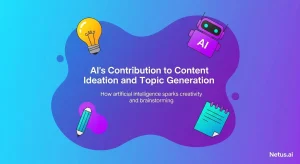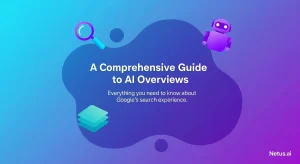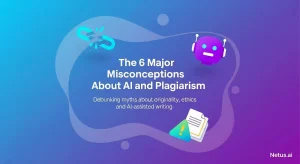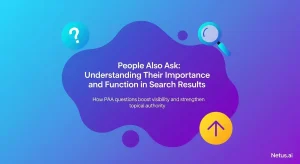How and Why to Avoid Duplicate Content: A Comprehensive Guide

Ashley Merit
Content writer and editor for Netus.AI
Table of Contents
Avoid Plagiarism with a Duplicate Content Checker Tool
How and Why to Avoid Duplicate Content. Ensuring the uniqueness of website content is crucial as duplicate content can adversely affect a website’s ranking in search results. Creating original content not only helps to engage the audience, but also avoids potential penalties due to plagiarism. However, duplicate content may unintentionally occur when multiple web addresses are created for the same site or webpage. This confounds search engines, leading to issues with search results and website ranking.
As users search for information online, search engines use algorithms to scan and display websites, blogs, or social pages corresponding to the users’ search terms. When identical information is present on various platforms, search engines typically choose to display only one result, often ignoring the others. Consequently, websites with duplicate content may experience decreased traffic and a lower ranking.
To address this issue, it is essential to employ a duplicate content checker tool for systematically detecting duplicated content and ensuring the integrity of a website. There are numerous tools available to help with this task, each with its unique features and capabilities. Some popular examples include Copyscape, Siteliner, Grammarly, and Screaming Frog.
These tools aid in identifying instances of scraped content that may have been taken from other sites by content scrapers. Using Google Alerts can also assist in monitoring potential instances of scraped content and take appropriate action when necessary.
By incorporating a duplicate content checker tool into your workflow, you can safeguard your website against the negative consequences of duplicate content. Being proactive about avoiding plagiarism and maintaining unique content will ultimately contribute to a better overall online presence, improved search engine ranking, and greater user engagement.
Utilizing these tools and strategies can effectively combat plagiarism, content scrapers, and other duplicate content issues, ensuring a strong and consistent web presence in the digital landscape.
Addressing the Importance of Resolving Duplicate Content Issues
Dealing with duplicate content issues is crucial to ensure optimal website performance, as various technical problems may cause websites to result in duplicated versions. This issue frequently arises from language changes or device adaptability. Although these problems do not lead to search engine penalties, they can cause traffic to be directed to non-preferred versions of the website, resulting in lowered rankings.
It is imperative to resolve these technical issues, as they consume the website owner’s crawl budget, further diluting the website’s rank. Properly addressing duplicate content ensures website optimization and an improved user experience.
A website’s performance hinges heavily on its user experience. Subpar websites containing stale content fail to retain visitors’ attention. Conversely, well-built websites attract significant traffic. Therefore, if there is a sudden decrease in search volume, it is essential to examine the potential causes.
Regrettably, many low-quality websites resort to plagiarizing content from more reputable sites. Scraping content from other sources can negatively impact the original site, as search engines may recognize the content as duplicate. Consequently, this affects the site’s reliability and placement on search engine results pages.
To protect website ranking and uphold content integrity, it is crucial to address duplicate content issues quickly. In cases of content theft, it is vital to report the situation to appropriate forums that handle such infractions.
By identifying and resolving duplicate content issues, website owners can maintain their search engine rankings while ensuring a top-quality experience for their visitors and protecting their original content from damaging effects of plagiarism.
Steps to Follow for Avoiding Content Duplication
To maintain the originality and uniqueness of your website content, it is crucial to avoid the duplication of content. By addressing several common issues, you can effectively prevent duplicate content and its negative impact on your website’s SEO. Here are some key steps to follow:
- Deal with internal duplicate pages: Ensure that duplicate pages within your website are removed or redirected to the original page. This can be done through 301 redirects, which help maintain link equity and direct users to the correct content. Using SEO tools can assist in identifying and resolving these technical issues efficiently.
- Select a preferred website version: It is common to have different versions of a website, with variations like http vs. https, responsive designs for different devices, or www vs. non-www domains. Choose one preferred version and set it up accordingly in the Google Search Console. This step helps search engines understand your preference and rank the selected version more effectively.
- Manage URL variations: URL parameters, such as session IDs and tracking codes, can lead to duplicate content issues. To tackle this, consider using canonical tags, which indicate the preferred URL to search engines and improve indexability.
- Review syndication and republished content: While syndicating or republishing content on other websites can help gain more exposure, it can also lead to duplicate content issues. Make sure to include original credits and a rel=canonical tag when sharing your content with third-party websites.
- Create unique product descriptions: When dealing with e-commerce websites, avoid duplicating product descriptions across multiple category or product pages. Instead, craft unique descriptions to ensure your content stands out and avoid potential SEO problems.
- Protect your content against plagiarism: Use plagiarism checkers to detect instances where your content has been stolen and republished without permission. This step helps you proactively prevent scrapers from taking advantage of your original content and impacting your website’s SEO.
By addressing these aspects and implementing the suggested solutions, you can effectively minimize content duplication and its negative impact on your website’s SEO performance. A well-structured content strategy, coupled with regular site audits and resolving technical issues, will ensure your website remains unique and authoritative, ultimately enhancing the overall user experience and search engine rankings.
Frequently Asked Questions
How does duplicate content affect SEO performance?
Duplicate content can negatively impact your website’s SEO performance since it creates confusion for search engines, making it difficult to determine which version of the content should be shown in search results. Consequently, this can lead to lower rankings and traffic. According to Moz, duplicate content occurs when identical content appears at multiple web addresses.
Which techniques can be adopted to avoid duplicate content issues?
To prevent duplicate content issues, consider the following strategies:
- Use 301 redirects to route users and search engines to the preferred version of a page.
- Implement canonical tags to signal the preferred version of a page to search engines.
- Produce unique and original content for each page on your website.
- Monitor your site for duplicate content regularly using tools like Copyscape or Google Webmaster Tools.
Why is original content crucial for search engine rankings?
Unique content is essential for search engine rankings because it helps search engines identify your website as a valuable and authoritative source of information. This leads to improved rankings and increased visibility, which attracts more traffic and enhances your website’s overall SEO performance. Original content also provides a better user experience, encouraging visitors to spend more time on your site and engage with your content.
What are best practices for addressing duplicate content across multiple domains?
To tackle duplicate content issues across multiple domains, consider these best practices:
- Carefully plan the website architecture and content strategy for each domain.
- Utilize 301 redirects to consolidate similar content under one domain.
- Employ rel=”canonical” tags to indicate the preferred version of a page when content must be displayed across multiple domains.
- Consistently update and improve content, particularly on the primary domain, to ensure its uniqueness.
How can canonical tags help manage duplicate content?
Canonical tags, or rel=”canonical” tags, are used to specify the preferred version of a page when multiple versions with similar content exist. By implementing these tags, you inform search engines which version should be indexed and displayed in search results—addressing duplicate content issues and preventing potential ranking penalties. Here’s a comprehensive guide on how to use canonical tags.
What is an acceptable level of duplicate content on a website?
While there is no specific percentage, it’s essential to keep the amount of duplicate content on your website as minimal as possible, ideally zero. However, small instances of duplicate content, such as short quotes or legally required disclosures, are unlikely to cause significant issues. Focus on producing unique and high-quality content throughout your website as a way to improve your SEO performance.

The Role of AI in Content Ideation and Topic Generation | NetusAI
AI’s contribution to content ideation and topic generation AI plays a crucial role in content creation and topic generation. Its effective application significantly reduces preparation

Leveraging AI to conquer writer's block | NetusAI
Overcoming writer’s block with AI Writer’s block affects all writers, new or experienced. Even for the most accomplished writers, this common and frustrating problem presents

AI Overviews: A Comprehensive Guide | NetusAI
A Comprehensive Guide to AI Overviews Google has integrated AI Overviews into its search results as a knowledge panel. This feature acts like an AI

6 Common Misconceptions Regarding AI and Plagiarism | NetusAI
The 6 major misconceptions about AI and plagiarism Regarding AI and plagiarism, numerous myths, misconceptions and assumptions are circulating. Let’s distinguish between fact and fiction.

My writing is repeatedly flagged as AI generated by detection software | NetusAI
AI detectors consistently identify my writing as AI generated Even original, human-written content can face challenges from AI content detection false positives, impacting copywriters and

People Also Ask: Understanding their importance and function in search results
People Also Ask: Understanding their importance and function in search results A People Also Ask (PAA) search result is a zero-click Google response. It presents
